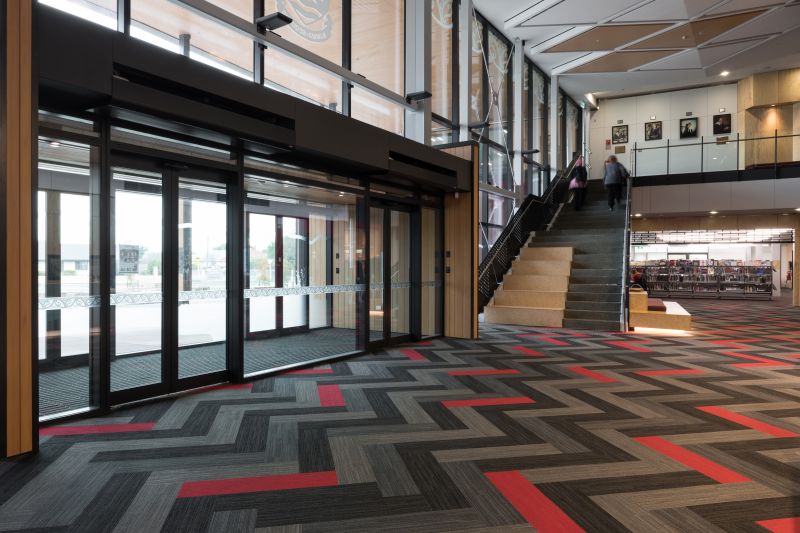
Image supplied by Jacobsen
As with many high use surfaces, school floors can face significant degradation over time.
For primary schools, maintaining attractive carpets and floors isn’t just about aesthetics, but functionality. Taking lessons while sitting on dirty, smelly or damp floors is distracting and unsanitary, creating a less-than-ideal learning environment.
Read the latest print edition of School News HERE
Carpets and floors may no longer be crucial seating areas in high schools, but they are still vital to maintaining an adequate learning environment. As winter sets in, students and staff will begin to track in rain and mud. This can result in a build-up on the floor that is distracting or hazardous, and arduous to clean. Consistently damp flooring can also cause humidity issues, contributing to problems like mould, and triggering respiratory illnesses.
One deceptively simple solution to these issues in the classroom is providing entry mats by the doorways. An entry mat may welcome staff and students into the room and make the place more visually appealing.
Entry mats can also make spaces more accessible, for example, creating a tactile division of space for low-vision students, or increasing grip and support for students with mobility considerations. Importantly for the winter months, entry mats can be absorbent and easily removed for cleaning. By providing entry mats to classrooms, dirt, mud and damp can be kept out of the flooring and may extend its life.
Entry mats are also in some cases required under the NZ Building Code (1992). For entranceways which may transition between wet and dry use, such as from the rainy outdoors to the dry indoor area, there is a requirement for an entrance matting area which absorbs most water. There is a suggested minimum area of 1.8 metres for absorbent matting. Another option is an extension of slip-resistance materials from the wet surface to the dry, so damp flooring does not become a slip hazard.
Entry mats are also a low-cost solution to entryways, ramps or other areas where improvement in grip is needed. Minimum standards for grip are needed for such sloped walkways, and should a full renovation be inaccessible, other low-cost options like strategically placed grip-tape may be useful temporary measures.
Areas of multi-use such as foyers, hallways, breakrooms and libraries may also have their own considerations. These high-use areas often double as lunchrooms, study spaces and rest areas. Comfort, practicality and aesthetic must therefore be balanced, along with durability considerations and maintenance. Carpet floor tiles may be the best option for some areas, as modular flooring enables easy replacement. Other options like linoleum tiles or easy-clean carpets may be appropriate depending on the area and its usual use.
Experienced professionals in the commercial flooring space should be able to assist with your school’s specific considerations, including where resurfacing may be a prudent health-and-safety matter. Additionally, they can advise on available commercial flooring options, which are usually designed to meet common concerns such as maintenance needs and comply with building specifications.
While safety is paramount, the value of aesthetic cannot be underestimated, either. Design and upkeep of a space can be a matter of school pride. It may be that your school is due for a redesign, perhaps to align with new values or to generate fresh motivation. Ensuring school property is presentable can create a surprising morale boost, creating benefits to students and the wider community beyond simply ensuring safe teaching and learning spaces.
Education Specialist from Jacobsen, Eamon McCreesh said the priorities for schools choosing flooring will be durability and fit for purpose. “There are requirements for safety and maintenance, and there’s always a budget, but there’s also room for creativity and innovation.
“Solution dyed Nylon (SDN) carpet tiles are extremely hard-wearing, stain resistant and fade resistant. If you choose a flooring manufacturer that is Cradle to Cradle certified, you can be assured that through a recycling program, the product can be fully recycled back into a carpet tile at its end of life.”
Mr McCreesh said corridors and stairs are some of the most highly trafficked areas in a school making maintenance, durability and slip resistance important in these spaces. “These are the pathways connecting all the other areas of a space so it’s important for them to be inviting, clean, and in many cases offer wayfinding designs.
“A good entrance matting provides your school with the first line of defence against slips, removing moisture and dirt and helping to protect the rest of your building, reducing cleaning costs. With excellent anti-slip properties, and highly durable, a quality entrance matting is the safe choice.
“Safety vinyl flooring is designed explicitly with slip resistance in mind. Its textured surface provides extra grip, reducing the risk of slips and falls. This is especially important in areas prone to moisture, such as cafeterias, kitchens, and bathrooms, where accidents are more likely to occur,” Mr McCreesh said.
“The main purpose of stair nosing is to increase the safety of your stairs. Stair nosing slightly increases the surface area which helps to reduce the risk of missing a step or losing your footing while going up or down. Tactiles can also be used at the top and bottom of ramps to reduce the risk of slips. This also creates a contrast for blind and low vision students.”
The much-delayed English draft curriculum is now out for consultation, generating discussion from teachers.
Research from AUT demonstrates arts, culture and recreation have positive impacts on all aspects of…
How effective has the school phone ban been in achieving its aims? Researchers from the…
School camps and excursions deliver hands on learning experiences, helping to consolidate classroom learning.
Innovations in AV technologies present new opportunities to engage with students. We look at how…
A new report from the University of Auckland’s Our Voices Project asks young people what…
This website uses cookies.